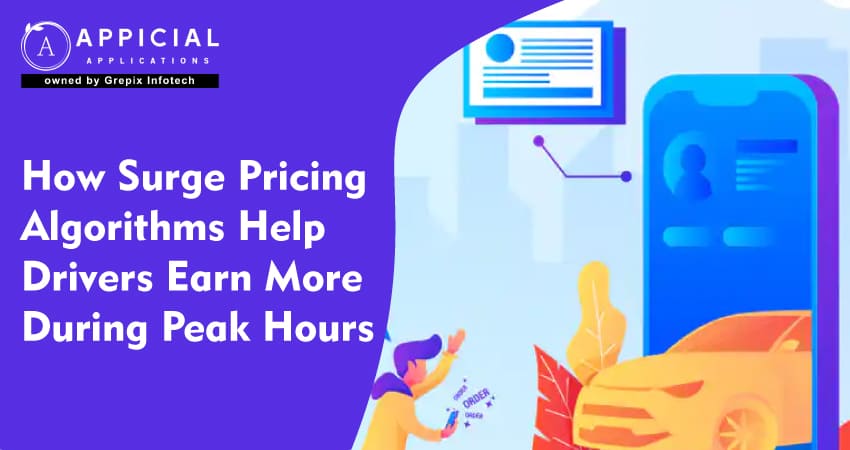
How Surge Pricing Algorithms Help Drivers Earn More During Peak Hours
In the rapidly evolving mobility industry, platforms offering ride-sharing, ride-hailing, or e-hailing apps increasingly rely on sophisticated pricing mechanisms. One such mechanism is the surge pricing algorithm, a dynamic price adjustment tool that activates when demand outpaces supply. For drivers, this means opportunities to earn significantly more during peak hours. For platforms offering an Uber Clone or a white label taxi booking app, integrating effective surge pricing is no longer optional. A competent taxi app development company, or a white-label taxi app development company, must design, implement, and optimise these algorithms.
In the sections that follow, we break down exactly how surge pricing helps drivers earn more, why it is critical to best-in-class apps, how to implement it, what the benefits and challenges are, and why partnering with Appicial Applications will give you a competitive edge.
In this blog, we explore why surge pricing algorithms are a critical feature of modern ride-hailing, e-hailing, and ride-sharing apps. We examine how they work, the benefits for drivers, the implementation challenges, and how a taxi app development company or a white-label taxi app development company can build one into your Uber Clone or white-label taxi booking app. The blog includes market statistics and technical insights, and ends with a call to action to partner with Appicial Applications to build such an app.
What Is Surge Pricing and Why Does It Matter to Drivers?
What does “surge pricing algorithm” mean in a ride-hailing app context?
A surge pricing algorithm in a ride-hailing, ride-sharing, or e-hailing app is a system that monitors supply (active drivers) and demand (ride requests) in real time. When demand rises significantly relative to available drivers in a geographic zone, the algorithm increases fare multipliers to incentivise more drivers to enter that zone. Research shows that ride-hailing platforms use dynamic pricing to coordinate supply and demand. For drivers, this means they receive higher fares per trip or per hour during high-demand periods. Implementation of surge mechanisms thus directly ties into driver earnings, especially during peak hours (e.g., rush hour, major events, late nights).
Why does this matter for a taxi app development company building an Uber Clone?
For a taxi app development company or a white-label taxi app development company building an Uber Clone or a white-label taxi booking app, embedding a surge-pricing engine is vital for driver attraction, retention, and platform health. Drivers will prefer a platform that lets them earn more rather than a flat-rate system with no premium during busy times. Without this feature, a ride-hailing app may struggle to maintain supply during peaks, which erodes user experience (long waits, cancellations) and ultimately driver earnings. Hence, integrating a surge algorithm is central to creating a robust, driver-friendly ride-sharing app.
How widespread is the adoption of dynamic fare mechanisms?
Empirical work suggests that platforms with flexible surge pricing generate large gains for drivers and platforms alike. For example, a study found that average individual drivers experienced a nearly 14% increase in weekly revenue in Chinese cities when surge pricing was in effect. Further research indicates that surge pricing improves allocative efficiency, reducing idle driver time by about 9.4% and increasing average trips per taxi by around 2.6% in some contexts. Given the global growth of the ride-hailing market, projected to grow from USD 270.81 billion in 2024 to USD 712.08 billion by 2033 at a CAGR of ~11.3%, any new e-hailing app must include surge pricing to remain competitive.
How Exactly Do Surge Pricing Algorithms Help Drivers Earn More?
Higher per-trip fare during high-demand windows
When demand spikes in a certain zone, the algorithm flags a surge multiplier (e.g., 1.5×, 2×, or higher). For each ride a driver accepts in that zone during the surge period, the fare is higher. This directly increases driver earnings for each trip compared to normal times. For part-time drivers especially, targeting surge windows means earning significantly more per hour. Research confirms that surge pricing widens the earnings gap between peak and off-peak. A well-designed ride-hailing app should clearly communicate upcoming or active surge zones to drivers so they can opt in accordingly.
Incentivising drivers to move into high-demand zones
Because surge pricing signals when demand exceeds supply, drivers are incentivised to reposition to those zones. A driver who accepts a surge zone assignment may reduce waiting time between rides and increase utilisation. The theoretical model shows that surge pricing helps induce drivers to enter the market during high-value windows. For a ride-sharing app built by a taxi app development company, providing a map or heat map of surge zones can help drivers respond dynamically, boosting their overall earnings.
Reducing idle time and increasing trip frequency
If surge pricing leads drivers to be in the “right place at the right time,” then idle time drops. Empirical data from surge studies show a ~9.4% reduction in driver vacant roaming time. With less wasted time and more frequently accepted rides, drivers can raise their hourly income. This means a white label taxi booking app that implements surge pricing effectively becomes more attractive to drivers in competitive markets.
Balancing supply & demand to maximise driver utilisation
In principle, if the platform balances supply and demand well, drivers spend more time with passengers than cruising. The algorithm helps maintain this balance by raising fares when demand is high, thereby encouraging supply expansion. That means fewer instances of long waits for drivers between rides or long dead-head drives. For a white label taxi app development company, building analytics and dispatch logic around surge events ensures drivers’ productivity is sustained.
Encouraging driver participation during less popular hours
By signalling to drivers that they will earn more during otherwise less-favoured hours (late night, early morning, weekends), surge pricing increases driver willingness to work at those times. This boosts availability, which in turn supports user experience and platform reputation. For the operator of a ride-hailing app, this means improved coverage and elevated brand positioning. For drivers, it means “premium time slots = premium earnings.”
What Are the Key Elements of a Surge Pricing Algorithm?
Real-time demand and supply monitoring
The foundation of a surge algorithm is real-time data: number of ride requests in a zone, number of available/idle drivers, historical patterns, traffic conditions, events, and weather. A research model emphasises that dynamically adjusting prices based on driver location and demand yields better outcomes. For a taxi app development company or white label taxi app development company, implementing robust telemetry and data pipelines is essential.
Zone segmentation and dynamic multiplier assignment
The area of operation must be divided into dynamic zones. When demand in a zone rises above a threshold relative to driver supply, the multiplier is triggered. The multiplier algorithm must take into account elasticities (how riders respond to price), driver supply, trip lengths, and fulfilment rates. Studies show that including surge factors in demand prediction improves accuracy by 12-15%. A well-engineered Uber Clone will build this factor into its demand-forecasting engine.
Driver notification and incentive logic
Once a surge is activated, drivers need to be notified (push notifications, in-app alerts) of the active zone and the multiplier. They should also have visibility of expected earnings or trip potential. Ensuring transparency helps drivers trust the system and increase participation. The ride-sharing app UX should facilitate this clearly.
Price transparency and rider communication
While the focus is on increasing driver earnings, rider experience must also be managed. Surge multipliers should show in the rider app to ensure fairness and transparency. If riders understand why the fare is higher and what triggers the surge, acceptance will be higher, reducing cancellations. According to research, surge pricing in ride-sharing apps also leads to more customer complaints when users feel unaware. It’s crucial that a white label taxi booking app built by a taxi app development company addresses this.
Duration control, cooldown and multiplier reset
When supply catches up with demand, the surge multiplier should gracefully reduce or be removed. A properly designed algorithm includes cooldown intervals, gradual drop-down logic, and avoids oscillations or erratic multipliers. This ensures driver earnings remain fair and predictable over time.
Historical data analytics and driver guidance
The system must capture historical data on surge events, driver responses, trip fulfilment rates, and user acceptance. This enables refinement of the algorithm. A ride-hailing app can provide drivers with suggested “surge windows” or “hot zones” based on historical patterns, thereby helping them plan better and earn more. The integration of analytics is where the taxi app development company adds value.
What Are the Benefits for Drivers and Platforms?
For Drivers Boosted Earnings, Better Utilisation
As noted, drivers can earn significantly more during surge periods compared to baseline. The 14% average weekly revenue increase in some cities (for drivers under surge pricing) underscores this. UCLA Anderson Review Drivers also benefit from reduced idle time, improved trip frequency and higher yield per hour. This increased earnings potential makes the platform more appealing, increasing driver retention.
For Platforms Improved Supply, Better Coverage, Higher Utilisation
For the operator of a ride-sharing app or ride-hailing app, efficient utilisation of drivers is critical. Surge pricing helps ensure that during peak demand, drivers are available. This improves service reliability (shorter wait times, fewer cancellations). It also helps the Uber Clone platform manage costs by reducing idle fleet and optimising driver allocation.
Revenue Uplift and Market Competitiveness
Platforms that implement surge pricing effectively can capture premium trips during busy periods and monetise willingness to pay. Surge algorithms enhance revenue per ride while still maintaining platform reliability. As the ride-hailing market grows (projected ~USD 712 billion by 2033), platforms that omit surge risk are price-undifferentiated and less attractive to drivers.
Demand Prediction and Operational Efficiency
Including surge factors in predictive models increases demand forecasting accuracy by ~12-15% in some studies. This enables platforms to allocate drivers in advance, reposition assets, and reduce dead miles. For drivers, this means fewer wasted hours and better earnings. For the platform, it means operational advantage. A white label taxi booking app that incorporates predictive analytics will stand out.
What Challenges Must a Taxi App Development Company Address?
Balancing fairness and transparency
While the aim is to boost driver earnings, surge pricing can be perceived as unfair by riders, especially if multipliers seem opaque. Studies show an increase in complaints due to surge pricing in ride-sharing apps. The e-hailing app must ensure clear communication and fairnessotherwise, user trust may erode. A robust taxi app development company must build a UI/UX that clearly and subtly explains surge pricing.
Driver behaviour and “chasing” surges
Drivers may abandon other assignments to chase surge zones, which can create inefficiencies, unbalanced supply in other zones and worse rider experience elsewhere. A well-designed Uber Clone must include guardrails or driver incentives to discourage purely “surge chasing” behaviour. The algorithm must optimise for overall system health, not just driver income.
Elasticity of rider demand
If multipliers become too high, many riders may cancel or shift to alternative modes, leading to lost trips. Research indicates that there is limited cross-platform substitution (upper bound ~0.26) when the surge is high. The ride-sharing app must test elasticity curves and ensure surge levels do not suppress demand excessively.
Regulatory and fairness concerns
In some jurisdictions, surge pricing is under scrutiny or a regulatory cap. For example, some laws propose limiting fares to 120% of what drivers earn during events. A white-label taxi booking app must adapt to regulatory constraints when operating across multiple markets. The taxi app development company must keep compliance in mind.
Technical complexity and algorithm reliability
Implementing real-time surge pricing algorithms is non-trivial. It requires robust infrastructure, real-time data feeds, geospatial analytics, fallback logic, driver interfaces, and monitoring dashboards. A taxi app development company must allocate sufficient resources for development, testing, and maintenance. Any failures (wrong multipliers, incorrect zones) can damage driver trust and platform health.
Incentive misalignment and driver experience
In some cases, full-time drivers may not benefit as much as part-time drivers from surge pricing if they cannot flex their hours. The ride hailing app must consider how to ensure equitable earning opportunities across driver segments.
How Can a White Label Taxi App Development Company Implement Surge Pricing Effectively?
Modular architecture for surge pricing
A quality white label taxi app development company will design the surge pricing component as a standalone module interfaced with dispatch, driver-matching, and analytics systems. This modularity allows for future refinement without disrupting core ride booking. For an Uber Clone, this means the scheduling and matching logic can evolve independently.
Real-time data pipeline and analytics
Implementing surge pricing demands real-time monitoring of driver supply, ride request influx, zone-level metrics, traffic and events. The development should include data stream ingestion, real-time processing, and integration with matching logic. The taxi app development company must ensure low latency and system resilience.
Driver dashboard and zone-heat map UI
The driver app interface should clearly show when surge is active, zone heat maps, expected earnings, and options to accept or reject surge-zone trips. A good ride-sharing app UX improves driver participation. The development company must prioritise intuitive design.
Rider UI and transparency
The passenger app must display the surge multiplier, explain why it’s higher (peak demand, zone shortage) and optionally provide alternatives (wait for a lower fare). Transparency helps reduce cancellations and complaints. The ride-hailing app needs trust from both sides.
Analytics and iterative optimisation
After launch, capture data on driver earnings, trip acceptances, cancellations, and rider behaviour. Use this data to refine multiplier thresholds, zone definitions, and notification timing. A white-label taxi booking app developed by an experienced taxi app development company will support this iterative cycle.
Compliance and regional customization
If deploying globally or regionally, the algorithm must accommodate local fare regulations, caps on multipliers, special event surges, and consumer protection laws. The development partner must build a flexible rules engine to adapt. For your Uber Clone, this means quicker market expansion.
Testing and fallback mechanisms
Before full launch, stress-test the surge algorithm in simulation. Build fallback logic: if supply suddenly drops or multiplier triggers erroneously, the system can reduce multiplier or send special offers to drivers. Ensuring reliability is key to driver trust and system stability. The taxi app development company must establish these safeguards.
Why Choose Appicial Applications for Building Your Uber Clone with Surge Pricing?
When you decide to build a ride-hailing app, ride-sharing app, or e-hailing app, you need a partner who understands both the mobility market and the technical intricacies of pricing algorithms. That’s where Appicial Applications comes in. Here are the reasons:
- We specialise as a taxi app development company with deep domain expertise in building Uber Clone and white label taxi booking app solutions.
- We architect robust surge pricing algorithms that monitor real-time supply and demand, assign multipliers, notify drivers and riders, and maintain system stability.
- We build intuitive driver dashboards, zone heat-maps, rider transparency interfaces, and regional customisation modules.
- Our services include end-to-end development: mobile apps (driver & rider), backend dispatch engine, analytics & reporting, surge module, and support for future expansion.
- We emphasise modular architecture so your ride-hailing app can grow: add new cities, integrate new vehicle types, modify multiplier logic, and launch marketing campaigns.
- We provide analytics dashboards that let you track key performance indicators like idle time reduction, trip frequency increase, driver earnings uplift, and overall platform utilisation.
- We ensure your platform is built with best practices for both drivers and riders, avoiding pitfalls like opaque pricing or unfair practices.
- Our white label taxi app development company model means you get a branded app, full code ownership, and rapid market launch.
Ready to build a high-performance Uber Clone or white label taxi booking app with advanced surge-pricing algorithms that help drivers earn more and users stay loyal? Contact Appicial Applications today for a detailed consultation and demo. Let us help you build a top-tier ride-hailing app that stands out in the market.
Conclusion
Surge pricing algorithms are no longer mere optional features in a ride-sharing app, ride-hailing app, or e-hailing app; they have become strategic imperatives. For drivers, surge means higher earnings, better utilisation, and more control. For platforms, it means better supply coverage, increased revenue, and improved operational efficiency. For anyone developing an Uber Clone or partnering with a taxi app development company or a white-label taxi app development company, ignoring surge pricing means missing out on critical value.
That said, surge must be implemented thoughtfully: with transparency, fairness, regional compliance and robust data architecture. A well-built surge pricing engine ensures drivers benefit, riders feel trusted, and the platform remains competitive. If you want to launch a surge-enabled ride platform that delivers value for drivers and users alike, Appicial Applications is your ideal partner. Let’s build your future in mobility together
FAQs
Author's Bio

Vinay Jain is the Founder at Grepix Infotech and brings over 12 years of entrepreneurial experience. His focus revolves around software & business development and customer satisfaction.
Back to blog list




